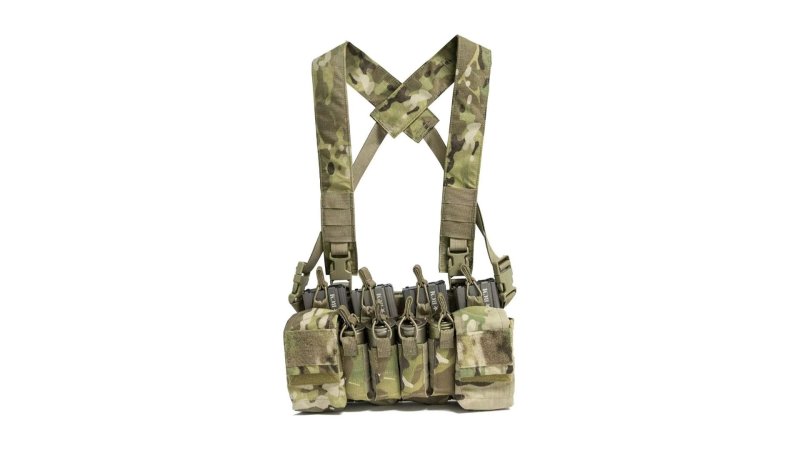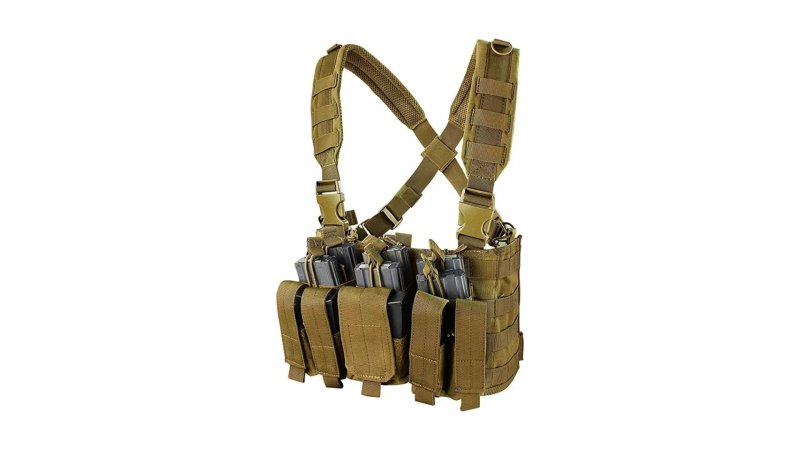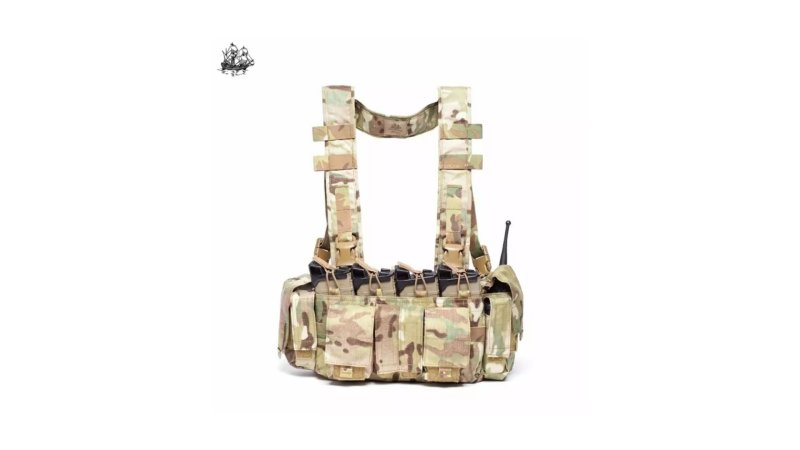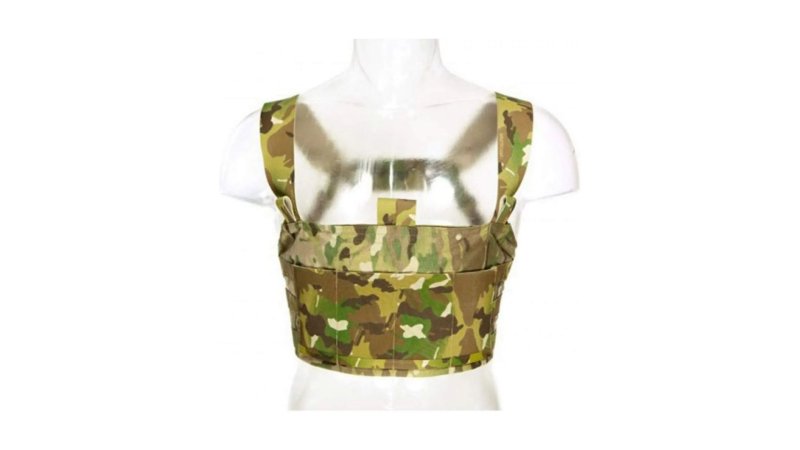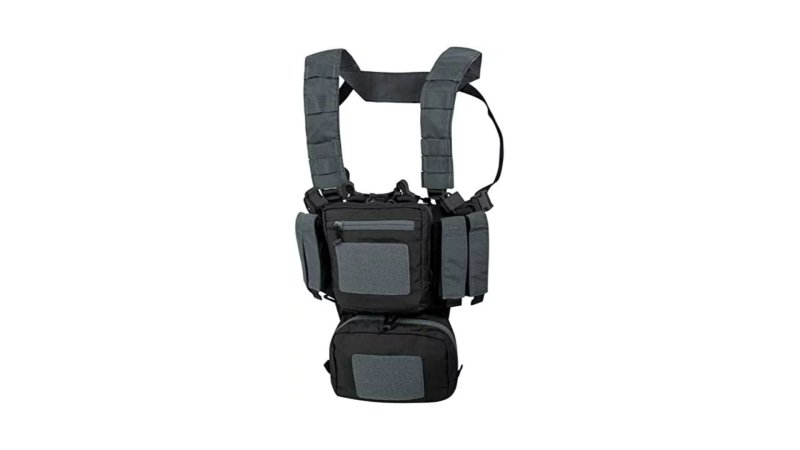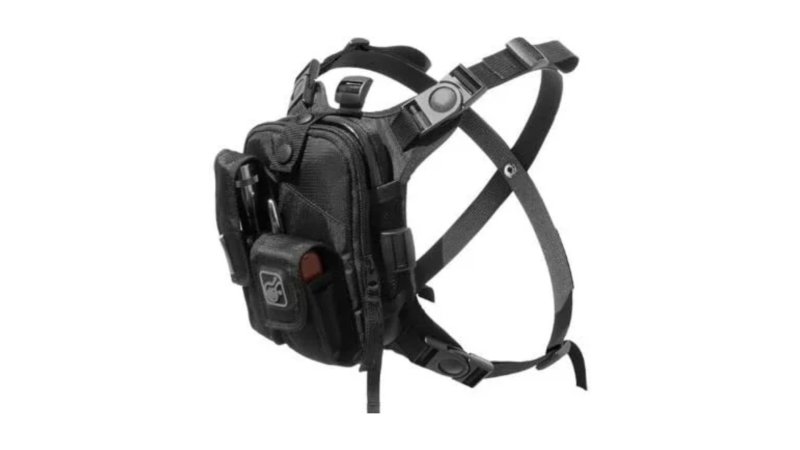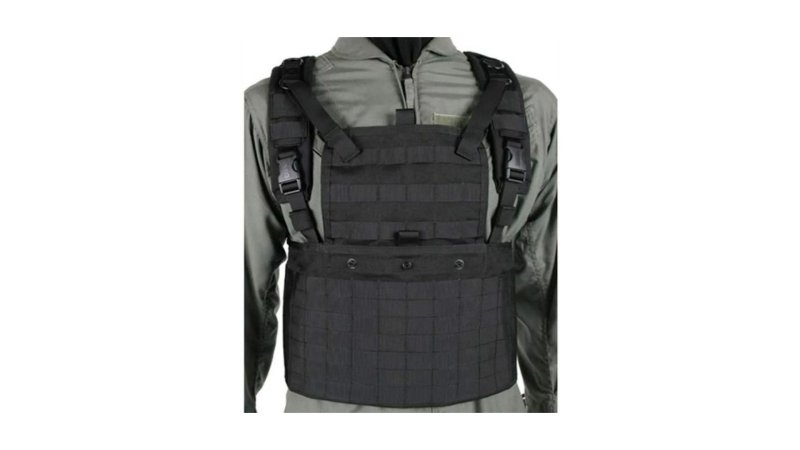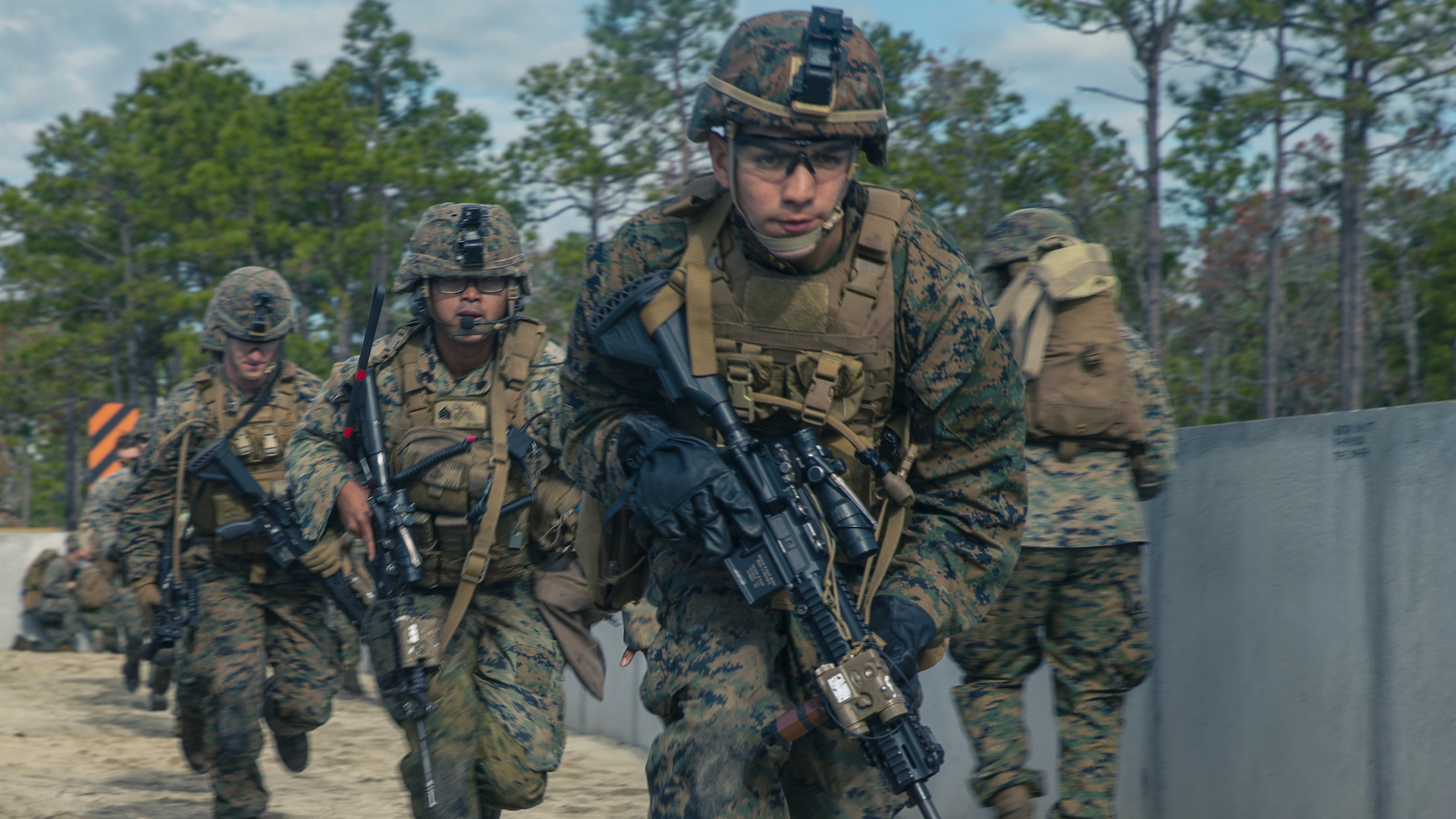

We may earn revenue from the products available on this page and participate in affiliate programs.
Chest rigs are the next evolution of load-bearing equipment that enables you to become the fast-moving lethal warrior you’ve trained to become. Most military veterans are familiar with load-bearing vests (LBVs), which were utilized as recently as the 1990s during the Gulf War. These systems were often uncomfortable, had limited customization and modularity options, and since they were designed to fit over bulky body armor, they were hard to fit properly without it. These older designs have evolved into a more versatile option that can be fully customized and work with or without body armor, which we call chest rigs.
While chest rigs offer less protection than plate carriers, they do offer more mobility and weigh less. These attributes can come in handy for various missions, but an added bonus is the ability to pack or store your body armor while still carrying ammo and gear. Those of us who had chest rigs would utilize this option during large unit hikes as we would be required to pack our body armor. Wearing our chest rigs would save space in the pack, even out the weight, and keep us ready for anything. To this day, I keep a chest rig in my go bag exactly for that reason.
So which chest rig is best for you? Let’s take a look at some of the best chest rigs on the market and help you find a worthy selection.
- Best Overall: Haley Strategic D3CRX
- Best Value: Condor Recon Chest Rig
- Editor’s Choice: Velocity Systems Mayflower UW Gen IV
- Best Concealable: Blue Force Gear Ten-Speed Chest Rig
- Best Range/Recreational: Helikon-Tex Training Mini Rig
- Most Discreet: Hazard 4 Covert Escape
- Best Bare MOLLE: Blackhawk Strike Recon Commando
Best Overall
Haley Strategic D3CRX
Pros
- SwiftClip-compatible
- Streamlined design
- Multi-mission pouches
- Velcro inserts available
Cons
- High price point
- Small-width waist strap
- No padding on harness
Product Specs
Best Value
Condor Recon Chest Rig
Pros
- Carries lots of ammo
- 4×4 MOLLE on the sides
- Swivi-Lockster for comfort
- Admin pocket
Cons
- Bulky upfront
- Only fits AR15/M4 mags
- Limited colors
Product Specs
Editor’s Choice
Velocity Systems Mayflower UW Gen IV
Pros
- Plenty of pouches
- SwiftClip-compatible
- Antenna routing loops
- Drop-down pouch compatible
Cons
- Limited colors
- 4-6 week lead time
Product Specs
Best Concealable
Blue Force Gear Ten-Speed Chest Rig
Pros
- Lays flat when empty
- 3×3 MOLLE sides
- Map/document pocket
Cons
- Limited colors
- Not SwiftClip-compatible
Product Specs
Best Range/Recreational
Helikon-Tex Training Mini Rig
Pros
- Fits AR/AK rifle mags
- Accommodates pistol or double rifle mag insert
- Three Velcro ID panels
- Casual patterns available
Cons
- No padding in shoulders
- Waist belt has only one clip
Product Specs
Most Discreet
Hazard 4 Covert Escape
Pros
- Unassuming appearance
- Swiveling clips for comfort
- Multi-purpose pack
Cons
- Smaller than preferred
- Not designed specifically for tactical applications
Product Specs
Best Bare MOLLE
Blackhawk Strike Recon Commando
Pros
- Fully customizable
- Can carry one armor plate
- Padded shoulder straps
Cons
- Only one color available
- Higher pricing for bare MOLLE
- No pouches included
Product Specs
Why you should trust us
During my tenure as an infantry Marine, I purchased and wore several bare and preconfigured chest rigs. I’ve combined this personal experience with the research skills developed as a writer for Task & Purpose to identify quality products for your next mission. I also tapped into my network for recommendations, thoughts, opinions, and reviews by industry professionals and hobbyists alike. Combining all of these together resulted in the list you just read.
Types of chest rigs
In order for you to choose the best chest rig, we need to identify them by their intended purpose. We’ve broken chest rigs down into three different categories based on the design and how you’ll be wearing them.
Bare
The most basic design of chest rigs is to have a panel with MOLLE webbing attached to it. These can be small chest placards or larger panels that wrap around the torso, and it looks bare or empty because it has no pouches. Bare rigs offer the most customization as you can alter the placement of pouches and choose what type of pouches are on the rig. While this style offers excellent modularity, it can feel bulky, especially if attaching pouches to pouches.
Purpose-built
Opposite of bare rigs are the chest rigs that are purpose-built. These rigs feature pouches that are sewn directly onto the chest placard or other pouches. This helps keep the gear tight into the rig and your body. Since the pouches are sewn on, there isn’t a lot of customization offered by this style of rig. Overcoming this just takes a little imagination and using pouches in creative ways to achieve your mission.
Concealable
Traditional chest rigs were designed to be worn over or instead of body armor, but there’s been an increase in the need for concealable rigs. These chest rigs are intended to be worn under larger shirts or jackets and keep your gear tight against your body.
Key features of chest rigs
Placard
The heart of any rig is the chest placard. These can be small or large panels of fabric and may have MOLLE webbing or sewn-on pouches. Any chest rig you purchase must have a placard to be effective and not waste your money. Look for a placard that offers enough space to carry all you’ll need and will fit properly around the base of your sternum.
Harness
In order to hold up the placard, chest rigs utilize one of three types of harnesses: X-harness, H-harness, or Y-harness. X-harnesses are probably the most common and feature two shoulder straps that cross behind your shoulder blades and connect to the placard. H-harnesses are similar, but the shoulder straps have a connector piece instead of crossing. Y-harnesses are less common, but some older designs use two shoulder straps that connect behind the shoulder blades into one strap and attach to a waist strap or belt.
Waist strap
To help keep the chest rig from bouncing around during operations, most rigs have a waist strap that connects to the bottom of the placard on each side. Better-quality chest rigs will often feature a pad or panel of MOLLE webbing on this strap as it should sit around the lower back above the belt line.
Pouches
The point of wearing a chest rig is to carry ammo and gear, which is done with the use of pouches. Most rigs will have at least a couple of rifle magazine pouches and one or two multi-purpose pouches. Other models will have pistol magazine pouches, radio pouches, or any number of utility pouches. Ensure that the pouches have some form of closure or retention so you’re not losing the gear during missions.
Benefits of chest rigs
Chest rigs have their place in tactical applications because of the benefits they offer. If you’re still unsure about using a chest rig, then you need to read on.
Save weight
The most obvious benefit of wearing a chest rig is how much lighter they are than plate carriers or body armor. Even if you take out the armor, plate carriers and vests weigh more than the majority of chest rigs. If you’re working in the mountains or will be on foot for any extended period of time, you will appreciate the saved weight.
Comfort
Comfort is always important when we’re talking about gear you wear on your body. Anyone who has spent 12 to 24 hours in body armor will tell you this. A chest rig’s less-rigid frame and adjustable harnesses allow you to custom-tailor the rig to your level of comfort. This will free up your brain to remain focused on the mission and reduce overall fatigue during missions. You’ll really notice the difference when wearing packs or rucks.
Silence
Not only are chest rigs capable of being quieter than body armor, but they also allow you to move quieter. This is because you’re saving weight, bulk, and are more comfortable. It all works to allow you to remain nimble and move silently for the reconnaissance or infil.
Chest rigs pricing
Budget
When you purchase a budget chest rig, you’re often trading quality or features for a lower price point. These are typically priced under $75, which frees you up to purchase the missing features or pouches.
Mid-range
Chest rigs priced between $75 to $150 are your mid-range priced rigs. These may have more features, but typically are made from better-quality materials than the budget options.
Premium
Offering top-of-the-line features and materials, premium chest rigs are typically priced over $150. These will normally be preconfigured and have the ability to work with other systems such as packs, body armor, or belts.
How we chose our top picks
To get the right products, each chest rig had to meet certain performance criteria and pricing considerations. Products with unrealistic claims or exaggerated prices were not considered for this review. We picked chest rigs that were made from rugged materials known for their durability. We also chose brands with reputations of reliability and consistency.
FAQs on chest rigs
You’ve got questions, Task & Purpose has answers.
Q: Is a chest rig better than a plate carrier?
A: When it comes to protecting your vital organs, plate carriers win. The good news is that you can have both or even combine the two and use them to adapt to your missions.
Q: Can you wear a plate carrier under a chest rig?
A: Absolutely, depending on the carrier. Streamlined plate carries may be more challenging, but we used to wear chest rigs over our MTVs and larger body armor vests.
Q: Where should your chest rig sit?
A: The placard should sit around the base of your sternum/rib cage, but you don’t want it too high where it affects your reloading ability. The waist strap will normally sit around the lower back while the X or H should sit in between your shoulder blades. Play with the placement to get it right to make sure it doesn’t interfere with wearing belts or packs.
Q: What should be on your chest rig?
A: This is all mission-dependent. Most chest rigs can carry one to three mags for each firearm you’re carrying, any light devices, notepads or other admin essentials, navigation devices, and/or medical supplies.
